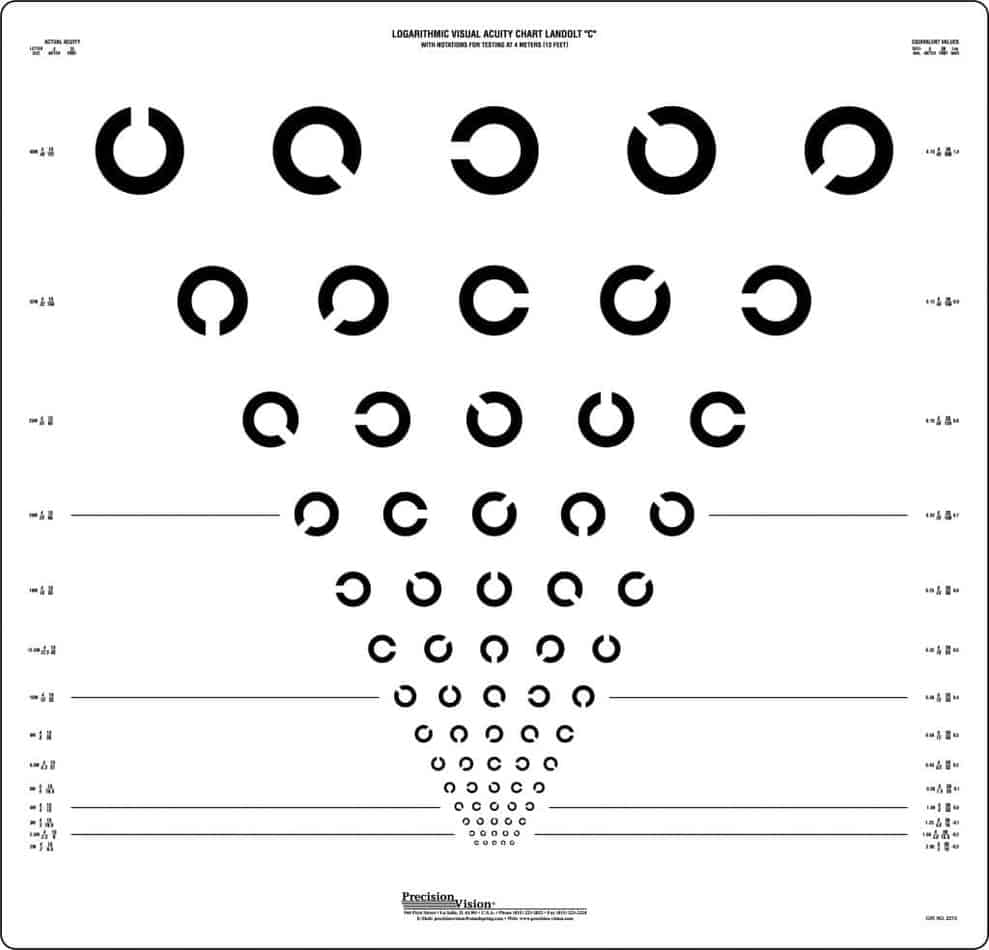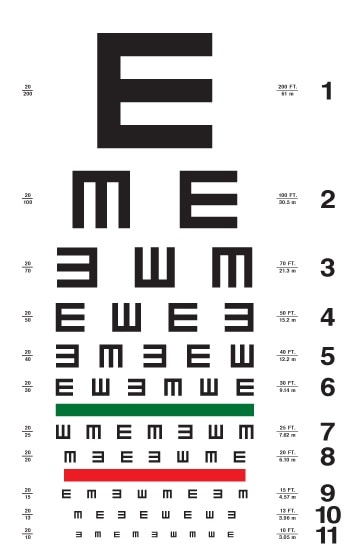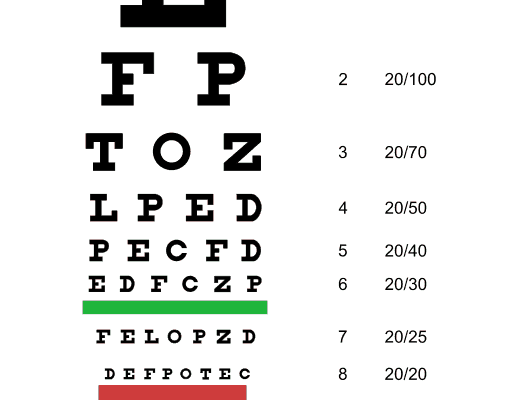Written by: Dr. Stephanie Mulick, O.D.
What is visual acuity?
Visual Acuity is measured using an eye chart. We are all familiar with the term 20/20, but what does that mean?

It is a ratio, the first number is the testing distance; for instance, 20/20 means that the testing distance is 20 feet away. The second number is the distance from which a normal eye based on “standard 20/20 vision” can see the image. So, someone whose visual acuity is 20/50 means what they can see at 20 feet away a “normal” eye can see 50 feet away. Basically, a person with a visual acuity of 20/50 has to be 30 feet closer to see the same object as someone who has 20/20 visual acuity. In the United States, visual acuity is measured in feet. Other countries use the metric system so 20/20 (feet) is equivalent to 6/6 (meters).
Visual Acuity Eye Chart
A Dutch Ophthalmologist named Herman Snellen created the Snellen visual acuity chart in 1862. He based his chart off of what he considered “standard vision” (20/20).
There are other types of visual acuity charts such as Jaeger chart, Landolt C and tumbling E eye charts. There are also pediatric eye charts with pictures that children can recognize as well as eye charts with numbers. The Jaeger chart is used to check near visual acuity and has a scale called the Jaeger scale with J1+ as the smallest or most acute near vision.

Landolt C and tumbling E charts have only one letter either a C or E that faces different directions. The patient is asked if they can tell which direction the letter is facing. These type of charts can be helpful for patients who are illiterate (unable to read or write).

When you have an eye exam your visual acuity will be measured one eye at a time. If your vision is worse than 20/40 you may be asked to look through a pinhole. A pinhole helps to determine if your vision can be improved with glasses. The pinhole reduces the amount of light coming into your eye effectively reducing the amount of blur on the retina and improving visual acuity. Pinhole acuity, like squinting, does not always improve visual acuity if someone has an ocular disease or cataracts.
Visual impairment and Legal Blindness
According to the National Institutes of Health, over 3 million people in the United States do not have normal vision (visual acuity worse than 20/40 with corrective lenses) even with glasses or contact lenses, unfortunately, the number of visually impaired is expected to more than double by the year 2050.
Visual impairment can range from mild to severe.
Visually impaired
A person is considered visually impaired if their visual acuity is 20/60 or worse with proper corrective lenses (glasses or contact lenses) in each eye.
Legally Blind
Legal blindness is defined as a person with visual acuity of 20/200 or worse in both eyes or loss of peripheral vision with a field of vision of 20 degrees or less. 20/200 means that what a normal (20/20) eye can see at 200 feet, the 20/200 eye would need to be 20 feet away to see the same object. A visual field of 20 degrees means that the peripheral vision is significantly reduced to only the central 20 degrees.
Causes for visual impairment
Many eye diseases can be diagnosed and treated by your optometrist or ophthalmologist (here is a link to my post on the differences between optometrist and opthalmologist). However, some eye diseases can result in permanent vision loss.
According to the World Health Organization, the major causes of visual impairment worldwide are:
- uncorrected refractive errors (myopia, hyperopia or astigmatism), accounts for 43 % of visual impairment
- unoperated cataract, 33% of visual impairment
- glaucoma, 2% of visual impairment
There are many other causes for visual impairment including, trauma, macular degeneration, diabetic retinopathy, inherited eye disease, stroke to name a few.
Conclusion:
Visual impairment can be extremely devastating making simple tasks difficult. Some ocular disease can be treated to prevent vision loss if diagnosed early. So, make sure to see your eye doctor regularly at least once per year to ensure proper diagnosis and treatment.
If you are struggling with vision impairment, talk to your eye doctor about low vision resources.
For a printable eye chart click here


